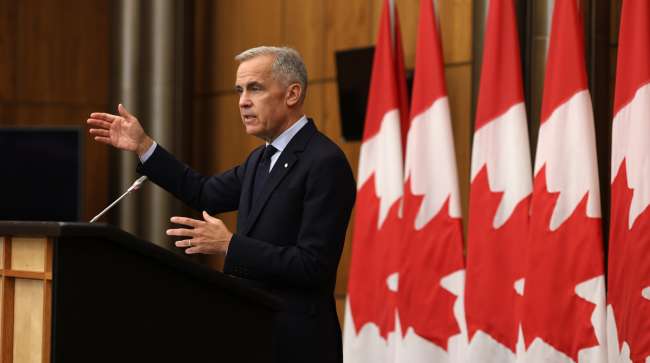Renewed Trade Dialogues Between Canada and the U.S.
Recently, diplomatic efforts between Canada and the United States have gained momentum, focusing on addressing tariff-related disputes that have affected several crucial sectors. Following a significant phone conversation on September 1, Canada’s representatives have traveled to Washington to further these discussions with U.S. officials.
Key Figures Leading the Discussions
Mark Carney, a pivotal figure in these talks, described the initial conversation as very constructive. Alongside top civil servant Michael Sabia, Canada’s team has engaged in ongoing meetings aimed at smoothing out trade relationships, especially concerning industries that have borne the brunt of tariffs.
Sectors Under the Spotlight
The discussions primarily focus on strategic sectors like automobiles, steel, and aluminum—industries severely impacted by the tariffs currently imposed by the U.S. Although Canada remains optimistic about reaching agreements in these vital areas, Carney tempered expectations, cautioning that visible breakthroughs are not immediate just yet. The nature of these talks suggests a gradual and detailed negotiation process.
Tariffs and Exceptions: A Complex Landscape
The U.S. administration had increased some tariffs on Canadian products from 25% to 35% starting August 1, though a significant exemption under the U.S.-Mexico-Canada Agreement (USMCA) allows a range of goods to avoid the harshest duties. This nuance effectively means Canada faces a blended tariff rate close to 5.5%, reportedly the lowest average tariff worldwide.
Still, legal challenges hover over these tariffs. A U.S. court recently ruled many of the administration’s tariff actions illegal, yet they remain in place as the government seeks further judicial backing. This back-and-forth creates uncertainty for businesses reliant on cross-border trade.
Trade Frictions Beyond the U.S.
Besides the North American front, Canada is also navigating trade difficulties with China. Recent retaliatory tariffs by China on Canadian products like canola and pork followed Canada’s own trade measures on Chinese electric vehicles. This tit-for-tat tariff environment complicates the export-import balance and adds layers of unpredictability to the global trade picture.
Table: Impacted Trade Sectors and Tariff Rates
| 部门 | U.S. Tariff Rate Before Aug 1 | Tariff Rate After Aug 1 | Exemptions Under USMCA |
|---|---|---|---|
| Automobiles | 25% | 35% | Yes, for qualifying products |
| Steel | 25% | 35% | 有限公司 |
| Aluminum | 25% | 35% | 有限公司 |
| Canola (by China) | 不适用 | Retaliatory tariffs imposed | No |
| Pork (by China) | 不适用 | Retaliatory tariffs imposed | No |
Logistical Ripple Effects of Trade Tensions
All these tariff adjustments stir more than just economic discussions—they ripple through logistics and supply chains. Industries heavily reliant on smooth, predictable freight movement experience disruptions that can inflate costs and cause delivery delays. For example, increased tariffs on steel and aluminum can lead to higher prices for manufacturing parts, and auto shipment volumes might fluctuate due to market uncertainties.
For freight forwarders, haulage companies, and courier services engaged in cross-border transport, such volatility presents challenges in route planning, customs clearance, and cost management. Adapting to shifting trade policies requires flexibility and awareness, making platforms like GetTransport.com invaluable for arranging cost-effective cargo shipping amid these uncertainties.
Making Sense of the Current Trade Climate
It’s clear the road to tariff relief is not a straight line. The mix of ongoing negotiations, legal battles, and retaliatory actions means businesses must stay vigilant. The conversations between Canada’s envoys and U.S. officials reflect a mutual interest in stabilizing trade, but patience is the name of the game—quick fixes are unlikely.
主要收获
- Negotiations focus on sectors hit hardest by tariffs: autos, steel, aluminum.
- Canadian officials expect gradual progress, not immediate resolution.
- Tariffs include U.S. increases, exceptions under USMCA, and China’s retaliatory measures.
- Legal wrangling over tariff authority adds uncertainty.
- Logistics and freight operations must navigate these shifting trade policies carefully.
Why Your Logistics Partners Matter Now More Than Ever
While no amount of honest reviews or reports can completely replicate the value of firsthand experience, platforms like GetTransport.com make testing these waters easier and more affordable. With access to a global network of cargo carriers, whether you’re moving bulky goods, vehicles, parcels, or relocating office or home items, you can compare offers and secure competitive rates, avoiding unnecessary expenses and headaches.
This transparency and convenience empower shippers to make informed decisions suited to their transport needs, all while navigating the ongoing twists in trade relations. GetTransport.com stands out by offering reliable, affordable, and versatile shipping solutions that align well with current logistics dynamics.
Book now on GetTransport.com to unlock the best offers in global cargo transportation.
Looking Ahead: What This Means for Global Logistics
Though these trade negotiations primarily concern Canada and the U.S., their impact on global logistics is more localized than sweeping. However, for companies operating cross-border shipments in North America and dealing with affected sectors, this is highly relevant. As the negotiations progress, staying up to date and flexible in logistics planning is critical.
GetTransport.com is committed to keeping pace with such developments, ensuring that shippers can access the most efficient and economical transport options. Start planning your next delivery and secure your cargo with GetTransport.com.
摘要
Canada’s engagement with U.S. officials marks a positive step toward resolving longstanding tariff issues impacting sensitive industries like autos, steel, and aluminum. Although breakthroughs won’t happen overnight, the conversations signal progress and a willingness to reach agreements. Additional trade frictions with China add complexity to Canada’s trade environment, reinforcing the importance of agile logistics strategies.
For freight, shipment, and delivery management, this evolving context highlights the value of reliable platforms such as GetTransport.com, which provide accessible global shipping solutions, ensuring smooth forwarding, haulage, and distribution across borders. Whether moving bulky goods, vehicles, or pallets, GetTransport.com supports efficient and cost-effective transport, helping businesses navigate these dynamic trade waters with confidence and ease.

 Progress in Canada-U.S. Trade Talks Aims to Resolve Tariff Issues Impacting Key Sectors">
Progress in Canada-U.S. Trade Talks Aims to Resolve Tariff Issues Impacting Key Sectors">